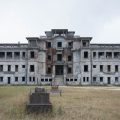Tuol Sleng Genocide Museum

The Tuol Sleng Genocide Museum (Khmer: សារមន្ទីរឧក្រិដ្ឋកម្មប្រល័យពូជសាសន៍ទួលស្លែង) is a museum in Phnom Penh, the capital of Cambodia, chronicling the Cambodian genocide. The site is a former high school which was used as the notorious Security Prison 21 (S-21) by the Khmer Rouge regime from its rise to power in 1975 to its fall in 1979. Tuol Sleng (Khmer[tuəl slaeŋ]) means “Hill of the Poisonous Trees” or “Strychnine Hill”. Tuol Sleng was only one of at least 150 execution centers in the country, and as many as 20,000 prisoners there were later killed.
History
Formerly the Chao Ponhea Yat High School,[2] named after a royal ancestor of King Norodom Sihanouk, the five buildings of the complex were converted in August 1975, four months after the Khmer Rouge won the Cambodian Civil War,[3] into a prison and interrogation center. The Khmer Rouge renamed the complex “Security Prison 21” (S-21) and construction began to adapt the prison to the inmates: the buildings were enclosed in electrified barbed wire, the classrooms converted into tiny prison and torture chambers, and all windows were covered with iron bars and barbed wire to prevent escapes.
From 1975 to 1979, an estimated 17,000 people were imprisoned at Tuol Sleng (some estimates suggest a number as high as 20,000, although the real number is unknown). At any one time, the prison held between 1,000–1,500 prisoners. They were repeatedly tortured and coerced into naming family members and close associates, who were in turn arrested, tortured and killed. In the early months of S-21’s existence, most of the victims were from the previous Lon Nol regime and included soldiers, government officials, as well as academics, doctors, teachers, students, factory workers, monks, engineers, etc. Later, the party leadership’s paranoia turned on its own ranks and purges throughout the country saw thousands of party activists and their families brought to Tuol Sleng and murdered.[2] Those arrested included some of the highest ranking communist politicians such as Khoy Thoun, Vorn Vet and Hu Nim. Although the official reason for their arrest was “espionage”, these men may have been viewed by Khmer Rouge leader Pol Pot as potential leaders of a coup against him. Prisoners’ families were often brought en masse to be interrogated and later executed at the Choeung Ek extermination center.
In 1979, the prison was uncovered by the invading Vietnamese army. In 1980, the prison was reopened by the government of the People’s Republic of Kampuchea as a historical museum memorializing the actions of the Khmer Rouge regime.
Ref: https://en.wikipedia.org/wiki/Tuol_Sleng_Genocide_Museum
Related Posts
Sihanoukville
A peninsula ringed by pretty whiteish-sand beaches and surrounded by a smattering of very attractive islands, Sihanoukville is...Bokor National Park
Bokor National Park is an unmissable trip out from Kampot. Explore the romantic, highly atmospheric old casino —...Botum Sakor National Park
Occupying almost the entirety of the 35km-wide peninsula northwest across the Gulf of Kompong Som from Sihanoukville, this...Kep National Park
The interior of Kep peninsula is occupied by Kep National Park, where an 8km circuit, navigable by foot...




